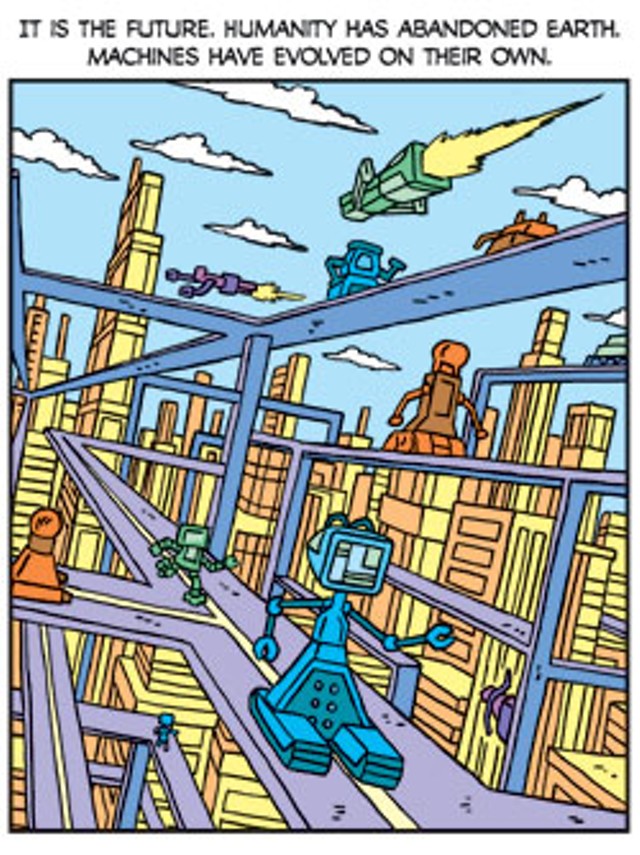Published October 30, 2013 at 10:47 a.m.
Twelve little boxes, hand-sketched, contain 12 fragments of a story; no single box is meaningful without the context provided by the others. Familiar stories stripped down to their basic ingredients are the basis for a novel creative project, called the 12 Panel Pitch, at the Center for Cartoon Studies in White River Junction. It has challenged students to reconsider what they know about visual storytelling — and is giving some of their stories national exposure on the online magazine Slate. More on that part in a moment.
The 12 Panel Pitch project began as an exercise for students of James Sturm, 48, cofounder of CCS. The initial idea was simple: Sturm gave his students just 30 minutes to come up with an original story that would abide by the conventions of a standard Hollywood genre film — horror, Western, romantic comedy, etc. — and then break it down into just a dozen key narrative “beats,” each told in a single-panel drawing.
Why 12 panels? “Originally it was 10,” Sturm says, “but that wasn’t enough. Twelve seemed to be the magic amount” — that is, neither too few panels to develop a feature-length film story nor too many to test online viewers’ short attention spans. “It’s all about restrictions,” says Sturm. “Talk to any cartoonist, any writer, and they’ll tell you that restrictions … enhance creativity, as opposed to diminishing it.”
In using the frameworks of familiar genres, Sturm hoped to get his students thinking about those genres’ deep structures. “We are all weaned on this stuff,” he says, citing the generic basis of Pixar films as a key to their success. “We’re absorbing these structures before we’re even talking. They’re part of our storytelling DNA.”
Sturm was initially uncertain that students would enjoy working with the conventions of popular fiction, but he found that they readily took to the challenge, temporarily suspending their “artsier” ambitions to throw themselves into genre-based storytelling.
Their success with the assignment — and the structural similarities between comics and films — gave Sturm an idea. He’d give the same “assignment” to novelists, screenwriters and professional cartoonists, and then give those stories to CCS students to illustrate, turning them into actual screenplay pitches. Instead of 120 pages of prose, the pitches would take the form of 12 cartoon panels. And so the project also challenges students to consider the modern media marketplace as they create their work.
Sturm enlisted a number of friends and colleagues, attracting well-known talent such as novelist Tom De Haven and cartoonist Jim Rugg. With Sasha Steinberg, a 26-year-old recent CCS graduate now living in Brooklyn, Sturm edited their pitches and passed them along to student and pro cartoonists to illustrate. (In keeping with the notion of the movie pitch, Steinberg receives the title of “best boy” in the credits; Sturm is “key grip.”)
De Haven, a writer and professor based in Virginia, has written for and about comics for decades. Genre storytelling, he says in a phone interview, is “totally hardwired.” De Haven, who wrote the script for a 12 Panel Pitch project called “Radiant”, finds genre to be an essential tool for developing a deep understanding about story structure. “Genres are great armatures for stories, particularly in the popular arts,” he says. “That’s why I’m interested in this project: to boil down story into its essences.”
Steinberg, who wrote three of the scripts for the project, says, “I think economy in storytelling is actually quite difficult … The idea of telling a story with just a few sentences and just 12 images sounds fast and easy. But the truth is that it takes an enormous amount of time and editing. Most of the work is about streamlining, analyzing what elements move the story forward, what elements are necessary to give it color, and then discarding everything else.”
Sturm says the project encourages students to demand “a little more” from the popular entertainment they all know well. Genre films offer the perfect opportunity to embrace and question the clichés and conventions of modern, mass-media storytelling. In “Radiant,” for example, the lead female character in the historical romance is heavyset. “At first, I thought, Send this back! Then I immediately thought that the way it was cast was the most interesting thing about it,” says Sturm, “because it runs contrary to what we expect from these things.”
So where does Slate come in? Sturm, who has written for the web magazine for several years, worked out an arrangement whereby it will publish the finished results of the 12 Panel Pitch project. Slate’s readers are invited to submit their own pitches for the 10th and final installment, to be drawn by Rugg. Meantime, new installments are posted on Slate every two weeks.
Now that the project has wider exposure, what happens if a web-savvy, comics-loving Hollywood producer comes knocking? Steinberg’s response is perfect. “Each of my scripts makes fun of overused narratives and character types. We don’t really need any more [genre] movies. But for what it’s worth, I think [the pitches] do seem pretty viable. So I would let the studios have that script and hopefully giggle all the way to the bank.”
New installments of the 12 Panel Pitch Project appear every other Tuesday on slate.com; the next is November 5. The deadline for submitting a pitch for the project’s final installment is December 13.
More By This Author
Comments
Comments are closed.
From 2014-2020, Seven Days allowed readers to comment on all stories posted on our website. While we've appreciated the suggestions and insights, right now Seven Days is prioritizing our core mission — producing high-quality, responsible local journalism — over moderating online debates between readers.
To criticize, correct or praise our reporting, please send us a letter to the editor or send us a tip. We’ll check it out and report the results.
Online comments may return when we have better tech tools for managing them. Thanks for reading.
















































